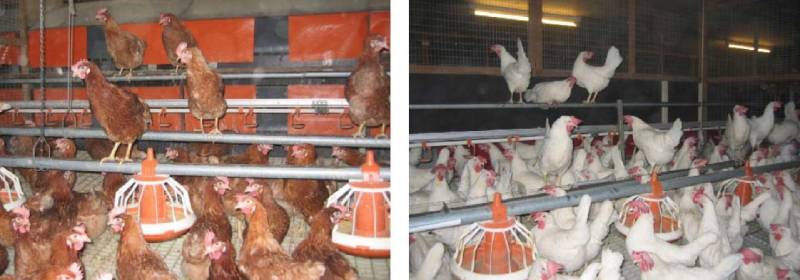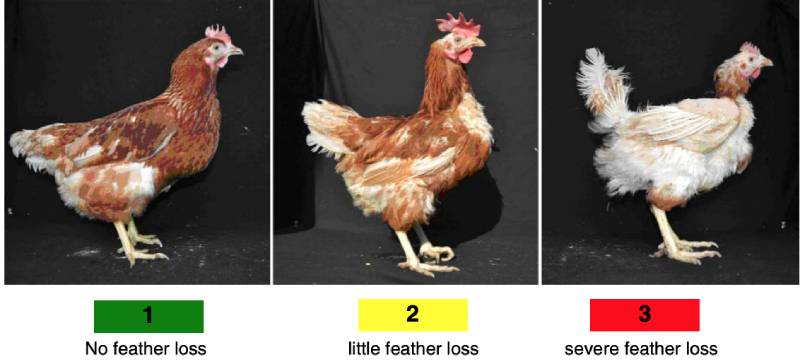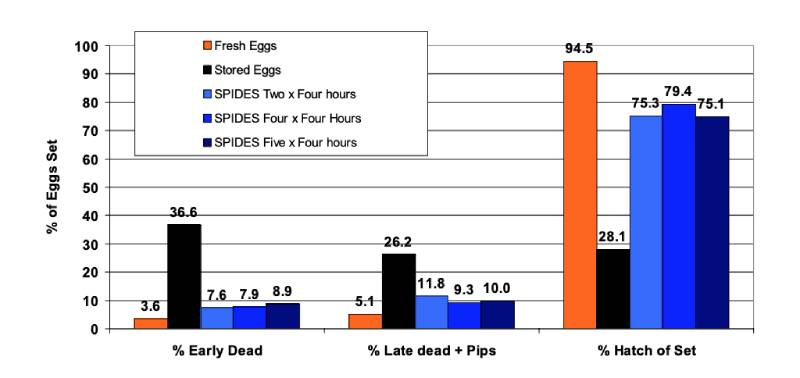Summary
Effects of infrared (IR) beak treatment of day-old chicks were compared with beak trimming at 9 days
with hot blade technique and untreated control groups. For this test, the Bavarian Poultry Research
Station in Kitzingen obtained day-old chicks of two strains from a commercial hatchery (1,800 LSL
classic and 1,800 LB classic), 1/3 of which had been beak-treated by IR technique in the hatchery.
The chicks were reared under commercial conditions in a windowless house with 6 pens of equal size, and one pen per strain was beak treated at 9 days, using a Lyon Debeaker (LD).
Effects of beak treatment on weight gain and feed intake were monitored throughout the rearing period. At 18 weeks, the pullets were transferred to two laying houses with windows and 12 floor pens per house. Data collected during the laying period (20-72 weeks of age) included daily mortality and egg production, weekly egg weight, four-weekly feed intake as well as subjective scores for feather condition and beak quality at the end of test. The following results were obtained:
• Slightly reduced weight gain due to beak trimming at 3 weeks (LSL) and 3-4 weeks (LB), but compensatory growth at 4 weeks (LSL) and 12 weeks (LB).
• No reduction of feed intake due to beak treatment in LSL pullets, but reduced feed intake of beak treated LB pullets throughout the rearing period.
• Somewhat better feed conversion for beak treated birds and a little higher early mortality for IR treated chicks.
• Significantly higher egg production per hen housed (+7 eggs/HH after IR and +4 eggs/HH after LD beak treatment).
• Although mortality was low in the untreated controls, a significant further reduction of mortality, especially due to cannibalism, was achieved with beak treatment. IR reduced cumulative mortality by 50%, and the production days lost due to mortality was only one third (-1.8 days) compared to the control group (-5.7 days).
• Feed conversion ratio and egg income over feed cost were improved by beak treatment, and the best results were found after IR treatment.
• Feather cover at the end of the laying period was better after beak treatment, especially in LSL hens.
• The beak condition at the end of the laying period was significantly better after IR treatment than after conventional beak trimming at 9 days with LD.
• Better beak quality of LSL hens in this test suggests that genetic differences in beak morphology and regrowth of tissue may exist, which should be taken into account while further improving and fine-tuning the IR technique.
IR beak treatment of day-old chicks has significant advantages over conventional beak trimming at 9 days and can be recommended as a contribution to improved bird welfare, without increasing production cost. Combined with optimal management, it can reduce the risk of feather pecking and cannibalism while geneticists try to solve the problem by selecting for improved picking behavior.
The chicks were reared under commercial conditions in a windowless house with 6 pens of equal size, and one pen per strain was beak treated at 9 days, using a Lyon Debeaker (LD).
Effects of beak treatment on weight gain and feed intake were monitored throughout the rearing period. At 18 weeks, the pullets were transferred to two laying houses with windows and 12 floor pens per house. Data collected during the laying period (20-72 weeks of age) included daily mortality and egg production, weekly egg weight, four-weekly feed intake as well as subjective scores for feather condition and beak quality at the end of test. The following results were obtained:
• Slightly reduced weight gain due to beak trimming at 3 weeks (LSL) and 3-4 weeks (LB), but compensatory growth at 4 weeks (LSL) and 12 weeks (LB).
• No reduction of feed intake due to beak treatment in LSL pullets, but reduced feed intake of beak treated LB pullets throughout the rearing period.
• Somewhat better feed conversion for beak treated birds and a little higher early mortality for IR treated chicks.
• Significantly higher egg production per hen housed (+7 eggs/HH after IR and +4 eggs/HH after LD beak treatment).
• Although mortality was low in the untreated controls, a significant further reduction of mortality, especially due to cannibalism, was achieved with beak treatment. IR reduced cumulative mortality by 50%, and the production days lost due to mortality was only one third (-1.8 days) compared to the control group (-5.7 days).
• Feed conversion ratio and egg income over feed cost were improved by beak treatment, and the best results were found after IR treatment.
• Feather cover at the end of the laying period was better after beak treatment, especially in LSL hens.
• The beak condition at the end of the laying period was significantly better after IR treatment than after conventional beak trimming at 9 days with LD.
• Better beak quality of LSL hens in this test suggests that genetic differences in beak morphology and regrowth of tissue may exist, which should be taken into account while further improving and fine-tuning the IR technique.
IR beak treatment of day-old chicks has significant advantages over conventional beak trimming at 9 days and can be recommended as a contribution to improved bird welfare, without increasing production cost. Combined with optimal management, it can reduce the risk of feather pecking and cannibalism while geneticists try to solve the problem by selecting for improved picking behavior.

Introduction
Beak treatment of laying hens is a „hot spot“ issue in animal welfare. In most EU countries, this prophylactic treatment is limited to a 5 year period, requires a special permit from veterinary authorities and has to be applied no later than 10 days of age. As demonstrated in many experiments (e.g. Eißele & Kraft, 1993; Lange, 1997; Damme, 2011), beak treatment of pullets is an effective means of reducing feather loss and cannibalism in laying hens. Even animal welfare organizations and politicians accept that banning beak treatment on short notice would only trade one welfare problem (pain of chicks from beak treatment) for another welfare problem (increased injuries and mortality due to cannibalism in adult hens). Two current field studies in Lower Saxony (11 farms) and Bavaria (15 farms) are designed to improve our understanding of primary causes of picking behavior in order to minimize the risk of cannibalism by optimized management practices, housing environment, nutrition, health and hygiene as well as lighting. A long-term solution should also include genetic selection (Bessei, 2012). This has been recognized as an important challenge by primary breeders, and responsible geneticists of Lohmann Tierzucht and Hendrix Genetics suggest at least 6-8 years as a realistic time window to expect significant improvements in practice from dedicated selection at the pedigree level. In the meantime, hen welfare can also be improved step by step, e.g. applying beak treatment earlier and with new techniques to minimize pain. In previous years, pullets were commonly beak treated with a hot blade up to 10 days of age on the growing farm. Nowadays, layer chick hatcheries are increasingly using the infrared (IR) technique from Nova-Tech, which had already been used for turkey poults since a number of years. The present study was designed to study the effects of different methods of beak treatment in commercial laying hens during the growing and laying period.Experimental design
A total of 3,600 day-old chicks, representing a popular white-egg (LSL) and brown-egg (LB) variety, were obtained from a commercial hatchery (Gudendorf-Ankum) and divided into 6 experimental groups: 1/3 per strain kept as untreated control, 1/3 beak treated with infrared technique (Nova Tech) in the hatchery, 1/3 beak treated with a hot blade (Lyon Debeaker) on the rearing farm 9 days after housing.The pullets were reared to 126 days (09.06-13.10. 2010) in a windowless house (30 x 12 m) with thermostatically controlled low pressure ventilation and spray cooling; 600 pullets per strain and treatment in a pen of 42.5 m² (8.32 m x 5.11 m); 14.1 birds /m²; nipple drinkers, chain feeders and gas brooders. Feed and water were offered ad libitum on floor level and on an elevated platform (Big Dutchman), which was easy to reach with help of an A-frame from week 3. Two thirds of the floor area had litter with heat treated soft wood shavings, one third had perches over plastic grids, with a manure belt underneath. The step-down, step-up lighting program was as described by Urselmans and Damme (2012). Prophylactic health treatment was organized by the Bavarian Poultry Health Service GGD. The following feeding program was used:

During the laying period the hens were kept in two window houses with 12 pens each, for 110 and 138 hens, respectively (8/m²). Each strain and treatment was thus tested with 496 hens in 4 replicate pens. Each pen had a litter area with wood shavings, 5 feeder pans and access to a common line of nipple drinkers.
Data recording
Rearing: Body weights were recorded from a sample of 80 birds per pen at 7, 14, 21 and 28 days of age. After 8, 12 and 18 weeks all pullets were weighed and feed consumption per pen determined. Mortality was recorded daily.Laying period: Egg production, mortality and apparent cause of death was recorded daily throughout the 52 week laying period, average egg weight and grading results weekly, and feed consumption at the end of each 28-day period.
Plumage condition was subjectively scored by two persons at 72 weeks of age, when the test ended. The 3 point system used is illustrated below:
 Subjective scoring system for plumage condition
Subjective scoring system for plumage condition

The quality of beak treatment was also scored by two persons at 72 weeks for 474 LSL and 369 LB hens from 8 pens, using a three point classification as illustrated below.

Score 1: beak closed (upper and lower beak of same length); rounded point; no growth beyond the edges; little bone material removed.
Score 2: length of lower and upper beak differs by 2-3 mm; parts of the growth beyond the edges broken off and/or up to 1/3 of beak bone removed;
Score 3: the lower beak is significantly longer than the upper beak (> 4mm) due to regrowth; crossed beak or bony base structure cut by more than 1/3.
Results
Rearing The beak treatment with infrared technique results in heat coagulation in all tissue cultures, and the necrosis involves about 1/3 of the upper beak and ¼ of the lower beak. An important advantage of this method is that no neuromas develop, which are relevant in connection with phantom pain after amputation (Haider, 2012).
Traditional beak trimming with a hot blade cuts off approximately one third of the upper and lower beak, and cauterization seals the blood vessels and prevents bleeding. Advantages and disadvantages of the two systems are summarized in Table 1. One advantage of IR is application in the hatchery on day one, leaving the beak morphologically intact until the dead tissue drops off at about two weeks of age. Beak trimming with the traditional hot blade technique before 10 days of age on the rearing farm has no effect on feed intake during the first days. This study was intended to show to what extent beak amputation affects feed intake and growth after treatment, based on weekly weighing of samples of 80 birds per strain and treatment.
Table 1: Advantages and disadvantages of IR beak treatment (van Niekerk, 2011; Haider, 2012)

Table : 2 Effect of beak treatment on body weight of LSL and LB pullets (g)

Table 3: Effect of beak treatment on feed consumption of LSL and LB pullets

Table 4: Feed conversion ratio (kg feed/kg weight gain) and mortality during rearing (18 weeks)

As shown in table 2, the beak treated LSL and LB pullets had a slightly lower body weight at 2-3 weeks, but the difference soon disappeared, and the beak treated groups were actually a little heavier at 18 weeks of age. Differences in feed intake (table 3) reflect not only different rates of growth, but also feeding behavior (including feed wastage) and activity. Table 4 shows larger differences in feed conversion ratio to 18 weeks of age between strains than due to beak treatment.
Mortality was low in all groups, and the differences are not statistically significant due to the small number of replicates.
Laying period
The analysis of variance showed significant differences between strains and beak treatment for henhoused egg production and mortality, expressed as production days lost due to mortality (Table 5).IR treated LSL hens laid 7 more eggs to 72 weeks of age than untreated controls. Although total mortality (Table 6) was very low in this test, beak treatment reduced the number of production days lost due to cannibalism (cloaca picking in LB, toe picking in LSL) significantly. The lowest mortality was achieved with IR treatment, and since the mortality in the treated groups started late, the economic loss was only 1/3 compared to the untreated control groups.
Table 6 shows the performance of LSL and LB hens with and without beak treatment. High levels of production and livability indicate good bird management throughout the test. While the white-egg layers LSL were superior to the brown-egg layers in hen-day egg production and egg income over feed cost (IOFC) in all three beak treatment groups, the IR treated groups outperformed the group with conventional beak treatment and the untreated controls. Hens with IR treatment of the beak tip at day old required 25 g (LB) and 48 g (LSL) less feed per kg egg mass than untreated controls. The IR treated groups exceeded the untreated controls by 22 and 49 cents per bird, respectively, or 220 (LB) and 490 (LSL) Euro more profit per 1,000 hens housed.
The advantage of IR treatment compared to traditional beak trimming was 15 (LB) and 38 (LSL) cents per hen housed, indicating that a higher price for IR treated day-old chicks is not only justified as a contribution to hen welfare, but also by elimination of beak treatment cost on the rearing farm and higher egg income over feed cost on the layer farm.
Table 5: Effect of beak treatment on egg number and mortality

Table 6: Effects of beak treatment on livability, egg production and feed efficiency


Feather loss during the laying period
The feather condition was judged for all birds at 72 weeks of age as described above and indicates interesting differences between strains as well as beak treatment (Figures 1 and 2). The LSL hens were scored better than the LB hens, which is probably due to the fact that brown-feathered hens look partially de-feathered as soon as the brown cover feathers are lost, while the White Leghorns keep their natural color until the skin becomes visible. Doubts remain whether our scoring system is a satisfactory measure to compare functional properties of the feather cover between different breeds or gives only a visual impression.Comparisons between beak treatment groups are consistent across breeds: 54.8% of the IR treated LSL hens had an intact feather cover at the end of test, compared to 35.0 % after traditional beak trimming and only 15.7% of the untreated control. The differences due to beak treatment were less consistent in the LB groups, where conventional beak treatment was apparently more effective than IR to prevent feather damage due to picking, but again the untreated control had the poorest feather condition.
Figure 1: Effect of beak treatment on feather score of LSL hens

Figure 2: Effect of beak treatment on feather score of LB hens

Quality of beak treatment
An intact beak of chickens is hook-shaped and pointed. The upper beak is longer than the lower beak and enables the hen to pluck and pull, select feed particles and to preen. The organ at the tip of the beak plays an important role for these functions.Therefore, the goal of any beak treatment must be to destroy as little live nerve tissue as possible and to induce quick recovery, while reducing the frequency of aggressive picking. The treatment should minimize pain and interfere as little as possible with feed selection, feed intake and preening, but prevent the misuse of the beak as a pair of tweezers to pull feathers of other hens. The goal is therefore a well closed beak without sharp or pointed ends. The quality and uniformity of beak treatment with the hot blade depends largely on the experience of the people doing the job. Additional factors to be taken into account with IR treatment are the size and uniformity of the chicks and adjustment of the machine.
The beak quality assessment at the end of the laying period (Figure 3) indicates that different strains may respond different to beak treatment, and these effects can be additive.
Figure 3: Subjective scores for beak quality at 72 weeks of age

The benefit of IR beak treatment, compared to conventional hot blade treatment, is more obvious for LSL than for LB hens. To what extent these differences reflect genetic differences in bone formation and potential for re-growth cannot be answered from a comparison of hens from a single hatch day, followed by beak treatment with the same setting of equipment.
As a basis for future refinement of the IR technique, more records on chick size (or age of parent flock) and settings of IR equipment should be collected for breeder flocks of different age and correlated with records on beak quality of adult hens. A realistic short-term target should be more flocks with similar beak quality as the IR treated LSL hens in this test, while geneticists continue to select for reduced picking and non-genetic factors contributing to picking are controlled as much as possible.
References
Bessei, W. (2012): Schnabelbehandlung beim Geflügel in der Praxis . Vortrag Eurotier, Forum Geflügel 14.11.2012.Damme, K. and S. Urselmans (2011): 8. Bayerischer Herkunftsvergleich von Legehybriden. In Geflügeljahrbuch 2012, S. 90- 98 Eugen Ulmer KG, Stuttgart ISBN 97-3-8001-7585-7.
Damme K. and S.Urselmans (2013): Infrarot-Behandlung als Brückentechnologie geeignet. DGS MAGA
Haider, W. (2012): Schnabelbehandlung beim Geflügel – eine wissenschaftliche Bewertung. Vortrag Eurotier, Forum Geflügel 14.11.2012.
König, E., R. Korbel and H.-G. Liebich (2009): Anatomie der Vögel. Schattauer GmbH, Stuttgart, ISBN 978-3-7945-2578-2;
Van Niekerk, T. (2011): Positief tot licht kritisch. Pluimveehouderij 41, 15.07.2011, 30-31.
Urselmans, S. and K. Damme (2012): 9. Bayerischer Herkunftsvergleich von Legehybriden: deutliche Unterschiede. DGS Magazin 18, 10-16.
Zusammenfassung
In einer Studie mit 1.800 LSL classic und 1.800 LB classic Hennen wurden am LVFZ für Geflügel in Kitzingen die Auswirkungen der Schnabelbehandlung auf Leistung, Mortalität, Federkleid und Schnabelmorphologie geprüft. Dazu wurden 1/3 der Küken mit dem Nova Tech Verfahren in der Brüterei Infrarot (IR) behandelt, 1/3 mit einem heißen Messer am 9. Tag gebrannt und 1/3 der Tiere diente als unbehandelte Kontrolle. Folgende Ergebnisse wurden erzielt:
• Tendenziell geringere Körpergewichte bei Schnabelbehandlung in der 3. Lebenswoche von LSL Küken und in der 3.-4. LW bei LB Küken mit voller Kompensation der Lebensgewichtsentwicklung ab der 4. LW (LSL ) und ab der 12 LW (LB).
• Kein Einbruch der Futteraufnahme bei LSL Küken zum Zeitpunkt der Schnabelhandlung. Tendenziell leicht geringere Futteraufnahme der gebrannten LB Küken in der 2. und 3. LW bei den IR behandelten Tieren über die gesamte 20 wöchige Aufzucht im Vergleich zur unbehandelten Kontrolle.
• Tendenziell eine bessere Futterverwertung der Schnabel behandelten Gruppen bis zur 18. LW. Geringfügig höhere Anfangsverluste bei IR Behandlung.
• Signifikant höhere Eizahl je Anfangshenne und Jahr bei den behandelten Tieren: +7 Eier mit IR und +4 ./AH konventionell gebrannten Tieren.
• Signifikant geringere Verluste (insbesondere durch Kannibalismus bedingt) bei den Schnabel behandelten Gruppen. Durch die IR-Behandlung konnten die kumulierten Verluste halbiert und der Verlust an Produktionstagen auf 1/3 der Kontrolle reduziert werden.
• Tendenziell bessere Futterverwertung und höherer Futterkostenüberschuss in der Legeperiode bei Schnabelbehandlung, wobei die größten Unterschiede zwischen dem IR Verfahren und der Kontrolle beobachtet wurden.
• Besseres Federkleid bei Schnabelbehandlung am Ende der Legeperiode, vor allem bei den LSL Tieren.
• Signifikant besserer Schnabelschluss und Morphologie des Schnabels zu Ende der Legeperiode bei dem IR-Verfahren im Vergleich zum Brennen. Genetische Unterschiede in der subjektiven Beurteilung der Qualität der Schnabelbehandlung zugunsten der LSL Hennen.
Das IR Schnabelbehandlungsverfahren zeigt während der Legeperiode deutliche Vorteile bezüglich Leistung und Mortalität und Federverlust gegenüber den unbehandelten Tieren und zusätzlich einen besseren Schnabelschluss im Vergleich zum Brennen am 9. Tag. Die Differenzen zur Kontrolle sind bei den LSL deutlicher ausgeprägt als bei den LB.
Damit erfüllt das IR- Verfahren, in Kombination mit einem optimalen Management, die Voraussetzungen einer empfehlenswerten Brückentechnologie bis zu einer erhofften endgültigen Lösung durch erfolgreiche Selektion gegen dieses Verhalten.
Acknowledgement The authors thank Prof. D.K. Flock for the translation of the manuscript.
订阅我们的新闻稿
了解所有最新行业新闻。







